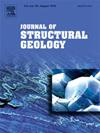Out-of-sequence recent thrusting revealed by surface and subsurface data under the Po Plain, Italy
IF 2.9
2区 地球科学
Q2 GEOSCIENCES, MULTIDISCIPLINARY
引用次数: 0
Abstract
Recognizing recent activity at buried out-of-sequence thrusts is a complex task but has important implications for seismic hazard and risk assessment. Here we propose an example of methodology that includes subtle geomorphological and hydrological observations at the surface correlated with upper crustal 3D reconstruction by seismic sections and stratigraphic logs. The densely inhabited Po Plain (Italy) hides the front of the Northern Apennines fold-and-thrust belt, buried under a thick succession of Plio-Pleistocene deposits. The Emilia Arc, located in the center of this front, is composed of a series of folds and south-dipping thrusts. Hindward of the thrust front, at the surface, high resolution Digital Elevation Models and GPS measurements allowed to discover topographic anomalies that denounce recent uplift and broad tilting. These have been accompanied by ample late Pleistocene-Holocene migration of the river network, and river over-excavation. In correspondence of these features, subsurface data show north-verging folds and reverse faults involving Pleistocene deposits. From this integration, a scenario where two out-of-sequence thrust zones contributed to modulate shortening during the late Pleistocene and, possibly, Holocene, emerges. Hinterland migration of deformation has been favored by the higher sedimentation load above the outer thrusts and their close confrontation with the thickened Southern Alps buried fronts.
意大利波河平原地表和地下资料揭示的逆冲断层
识别埋藏逆序断层的近期活动是一项复杂的任务,但对地震灾害和风险评估具有重要意义。在这里,我们提出了一个方法的例子,包括微妙的地表地貌和水文观测与地震剖面和地层测井的上地壳三维重建相关。人口稠密的波河平原(意大利)隐藏着亚平宁山脉北部褶皱冲断带的前缘,埋在厚厚的上新世-更新世沉积层之下。位于该锋面中心的艾米利亚弧由一系列褶皱和南倾逆冲构造而成。在逆冲前缘的背面,在地表,高分辨率数字高程模型和GPS测量可以发现地形异常,这些异常表明最近的隆起和广泛的倾斜。这些都伴随着大量的晚更新世-全新世河网迁移和河流过度开挖。与这些特征相对应,地下资料显示北向褶皱和涉及更新世矿床的逆断层。从这种整合中,出现了两个逆冲带在晚更新世和可能的全新世期间导致调制缩短的情况。外部逆冲构造上方较高的沉积负荷及其与加厚的南阿尔卑斯隐伏前缘的近距离对抗有利于变形的腹地迁移。
本文章由计算机程序翻译,如有差异,请以英文原文为准。
求助全文
约1分钟内获得全文
求助全文
来源期刊

Journal of Structural Geology
地学-地球科学综合
CiteScore
6.00
自引率
19.40%
发文量
192
审稿时长
15.7 weeks
期刊介绍:
The Journal of Structural Geology publishes process-oriented investigations about structural geology using appropriate combinations of analog and digital field data, seismic reflection data, satellite-derived data, geometric analysis, kinematic analysis, laboratory experiments, computer visualizations, and analogue or numerical modelling on all scales. Contributions are encouraged to draw perspectives from rheology, rock mechanics, geophysics,metamorphism, sedimentology, petroleum geology, economic geology, geodynamics, planetary geology, tectonics and neotectonics to provide a more powerful understanding of deformation processes and systems. Given the visual nature of the discipline, supplementary materials that portray the data and analysis in 3-D or quasi 3-D manners, including the use of videos, and/or graphical abstracts can significantly strengthen the impact of contributions.
 求助内容:
求助内容: 应助结果提醒方式:
应助结果提醒方式:


